It is likely that the fife as we know it today probably arrived in Brazil at the hands of the Jesuits and the Portuguese military, and was then introduced to the indigenous people. It was taken to the sertões by mixed populations, this at the time of 1500-1600. There are currently hundreds of bands in Brazil, mostly made up of descendants of the first fife cad a few centuries ago. It is interesting to note that the fife was introduced to the population in two ways: the indigenous route, which dates back to the colonization period, from the introduction of the fife by the Indians and has a second route – in Minas, for example, where it is linked to blacks, without any indigenous trace and with a military touch.
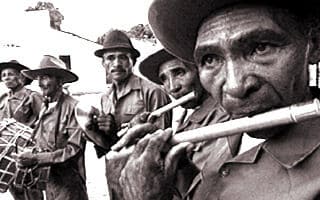
Nowadays it is possible to find fife bands in a large number of cities in the northeast, north of Minas, notably in the interior. In the capitals or in the big cities, the same tradition is no longer kept. These groups are known by different names, depending on the region where they operate: Banda de Pífanos, Banda de Pife, Música de Pife, Zabumba, Cabaçal, Esquenta-Mulher, Banda de Negro, Terno, Banda de Couro (Goiás), Musga do Mato , Pipiruí (Minas Gerais). Just as their name varies, the composition of these bands also has significant differences, but they are basically composed of two fifes, a surdo, a snare drum and a bass drum or zabumba.
Indigenous peoples in Brazil made, and still make, flutes made from taboca bamboo. This is an instrument that has a strong presence among the different Brazilian indigenous groups. Other countries such as Bolivia, Peru, Uruguay, Mexico and Colombia, also present in their musical culture, wind instruments identical to the Brazilian fifes, but with other names. In addition to these, very similar instruments are found all over the world, such as the Japanese shinobue, nohkan and ryuteki, and the Indian bansuri .
“The sound of pife came from the forest. It came from the Indian and was passed from generation to generation”. João do Pife, pig maker of Caruaru
novenas
There is a relationship of affinity and dependence between fife bands and Catholic rites, especially during novenas – a meeting for prayers, held over a period of nine days, in devotion to the Holy Trinity, the Virgin Mary, angels or saints. In the Northeast, novenas take place practically throughout the year. Among the most celebrated are São Sebastião, São José, Santo Antônio, Santa Luzia, Nossa Senhora de Lourdes.
The repertoire cad is the blessed, the prayers, often accompanied by beatas and devotees singing in Latin. In novenas, the band is of great importance – from the opening moment, when the flagpole is placed, until the end of the nine days. Religious festivals help safeguard the fife bands and the musicians' family budget. “A novena without a pife band is almost a wake”, says José Cesário, from the band Frei Damião, from Tabira, in the sertão, 400 kilometers from Recife.
Recently, the fife ceased to have a more religious connotation and became part of other manifestations. It became the embryo of musical genres linked to forró, is present in carnival blocks and started to be introduced in the commercial music cad , gaining space through records, CDs, videos, concerts, digital media, etc.
pipers
I make pife, I play pife, I sell pife, I eat with the money from pife and when I get old I get pifa – João do Pife
Pifeiro is a self-taught musician, he knows the songs, the melodies orally, many of them created by himself, by other bands or by someone he knows and knows by ear. In general, he is a member of a family of pifeiros, or is within a community where he learns by ear. References to it are visual and aud . The members of the bands are, for the most part, rural workers engaged in subsistence agriculture in their small quena . They are simple people, who deal with the countryside, plantations, cattle, located in a social level that is sometimes less favored. But this is not just a characteristic of pifeiros because, in the old days, those who played in music bands were slaves who performed other services and played various instruments. For some time now, urban pifeiros have also emerged who learned the fife through records, CDs and other media.
Some of the most famous pifeiros are those that are part of the ancestral history of this instrument. João do Pife, from the band Dois Irmãos, is an icon of fife bands in Brazil, having played in more than 27 countries. According to him:
the pife musician, to become a master, has to make, play and teach everything about the instrument.
Born in 1943, João do Pife learned to play and produce bamboo fifes with his father in his childhood, while working in the fields, and even today he maintains the Dois Irmãos Fife Band created by his father in 1928. He is currently a teacher, teaches how to build the instrument based on standard measurements, probably inherited from their ancestors. This practice is guided by an oral culture, transmitted to his disciples. However, this experience turns out not to be accessible and does not provide for a greater dissemination of this knowledge to a wider audience.
Musicians such as: Edmilson do Pífano (PE - Banda Flor de Taquary), Zé do Pífano (PE - Banda de Pífanos de Caruaru), Chau do Pife (AL) and Alfredo Miranda from Viçosa do Ceará (CE), Anderson do Pife from Caruaru ( FOOT). They tell stories very similar to the story of Mestre João do Pife, where learning happened as a child, passed down by his ancestors and they say that the instrument has been present in the family culture for generations.
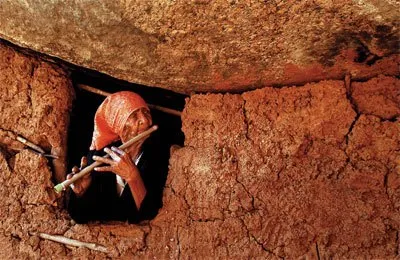
But among all these icons of folk music, a woman was a character of fundamental importance in the propagation of the fife in Brazil. Izabel Marques da Silva, better known as Zabé da Loca. Woman who broke all paradigms related to this culture that has always been predominantly male. Her work was discovered and recognized by the rest of the country when she was already 79 years old (2003), but Zabé started playing at the age of 10. Coming from a family of farmers and flutists, she learned the instrument from her brother. For these people who are used to putting their hands in the ground and understanding the cycles of nature, their roots are their foundation and music is part of those roots. Passionate in body and soul, Zabé loved to play, dance and have fun, even playing in environments that were theoretically forbidden for women. His firmness and joy were such that no one would question it. For her, life was always perfect and abundant, even with all the adversity, she had no time to complain. In spite of an enormous musical wealth, and a contagious joy, Zabé lived a simplicity that impressed even her countrymen. The flutist understood like no one else that you need little to be happy. She had 3 children from her only marriage and soon became a widow, not always having food to serve her children. At a given moment in his life, his simple mud house was destroyed after a storm, so Zabé went to live under a rock. There she built her new home and lived there for zen of years. This is where the name “Loca” comes from, the name given to this type of dwelling inside stones. This simple little house inside a stone became the symbol of this warrior woman and out of her time. After discovery, the artist traveled the whole country taking her art and at the age of 85 she received the Brazilian Music Revelation Award. Zabé da loca lived to be 93 years old (2017), and still enchanted all of Cariri with his joy.
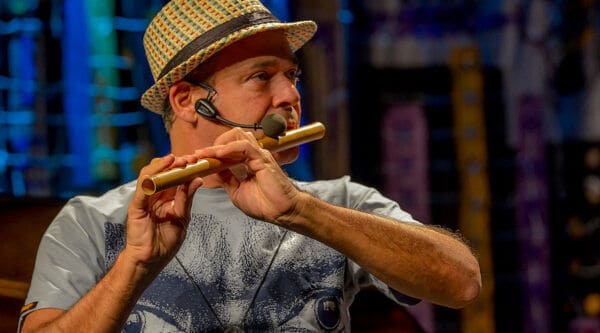
Pife today
Interest in the beautiful and exotic sound of pife has been growing. Renowned multi-instrumentalist Carlos Malta modernized fife bands with his work “Pife Muderno” taking this musicality from the Northeast to Rio de Janeiro. Carlos Malta played for a long time with Hermeto Pascoal, who is from Alagoas, and who influenced him a lot. Also in Rio, we have the “Tupife” block, which brings all the joy, theatricality and magic of the folk culture of the Northeast to Rio’s carnival. In Botucatu, São Paulo, the Pife movement is made by Zé Cláudio, and there is also the Bloco de Pífanos that moves the Carnival in São Paulo. In Campinas, Carlos Valverde is the one who rescues this culture. In Minas Gerais we have the Cataventoré group, there is the “Cor de Fubá” group and in Uberlândia there is another group called “Pifarinha”, which even recorded a CD. Further south, there are reports of pifeiros in Paraná and Rio Grande do Sul. The Pifano seems to be spreading across the country.
The shape of the instrument was also updated. The instrument that in the culture of the North and the indigenous people was originally made of taboca, a plant of the bamboo family. And that for some cultures it may even have been made of bones, today it can also be found in aluminum and pvc.
A little more about its history
Fife bands are composed of wind and percussion instruments, but this definition seems to have started in the 60s, because until that time they were called Zabumba or Cabaçal. The band's name was probably an influence of rock bands that started in the cad 's. Bibliographic information about the emergence of fife bands in Brazil is few and contradictory. Certain authors support the eur origin of these formations, others the African and others claim that they come from the indigenous environment.
It seems that the word fife comes from the German: Pfifer, which in this language means whistle. Corroborating the eur origin of this instrument, fifes also exist in France and England (in military music).
In Larousse, Encyclopedia of Music, we also find mention of the existence of fifes in eur Antiquity:
In France, wind instruments formed part of the constitution of the Grand Cavalry. Appropriating both brass and woodwind instruments, they were composed of oboes, bassons, crumhorns, bagpipes, fifes and drums, trumpets. We were able to ascertain that some of these instruments were used at the coronation of Louis XIV, and in the nave of the cathedral they probably performed splendidly.
We can also find out the Portuguese origin of the fifes:
The shepherds, when guarding their cattle, always carry a quena flute, which in Beira-Alta is called a pifaro (piphane). These flutes in some lands of Traz-dos-Montes, where they are called fraitas, are very well engraved. (Melo, 1882, p.238).
He reports an observation in loco, which he carried out in Serra da Estrela, Portugal, on September 4, 1916:
Next to the tent were two shepherds, (…). One of the shepherds plays the fife and the other sits on the ground, listening to his partner's music. (Melo, 1927, p.181).
He also describes the use of wicker, a kind of bamboo or bamboo, for the manufacture of fifes:
(…), for example, in Barco (Fundão) [region of Portugal] they are made of wicker, pierced with a hot iron” (Oliveira, 1966, p.184). Still talking about the fifes, Oliveira cites their use together with percussion: (...), the holes are located in the body, in a variable number according to the regions: in the North and East of Trasmont, namely in Terras de Miranda, and in the band alemguardiana alentejana, they usually have three holes, two on the top and one on the bottom, and are held and played with one hand. This type is thus the only one that allows the simultaneous playing of the tambourine and the flute by the same person. (…) (Oliveira, 1966, p.183).
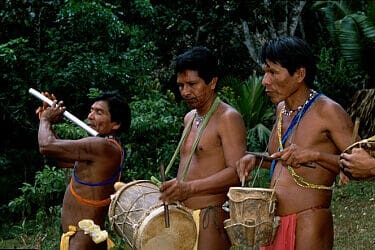
We can deduce that the fife was used in Brazil since the beginning of colonization and often accompanied by percussion instruments. We also note its use by Indians and blacks, people who formed the Brazilian population. As for his probable black origin, in addition to the obvious observation about the wide use of percussion by the peoples of black Africa, Abelardo Duarte refers to an article in the Portuguese magazine Panorama called “Teatro Medieval em são Tomé e Príncipe”, in which its author , Fernando Reis, describes the orchestra that accompanies the aforementioned auto:
The orchestra is made up of three cad bamboo flute players, two or three sucalo or sucaia cad – rattle corruption (…). (Duarte, 1974, p.122).
This African orchestra, with formation very similar to fife bands, makes us reflect on this probable kinship. We cannot say specifically whether the origin is from a particular country, region or cultural group. Portuguese percussion ensembles and rustic flutes; the use, by Brazilian indigenous peoples, and the bamboo and bone flutes and membranophones of the African tradition provide us with features present in the cabaçais ensembles (pife bands). However, the most sensible thing would be to say that elements of these three musical cultures amalgamated and formed the cabaçais ensembles in Brazil, making it clear that the flute is closely related to our people and our entire cultural mix.
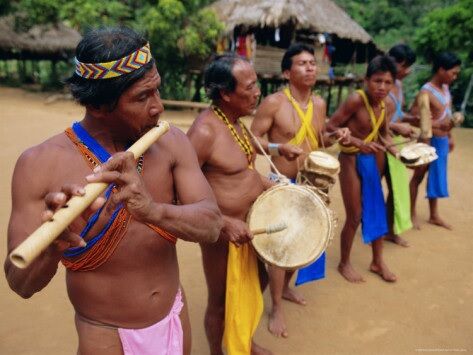
References:
- Brazilian beef
- Researches about Pife
- fife bands
- Brazil Network
- BAND OF FÍFANOS DE CARUARU A musical analysis – Master's Thesis by Carlos Eduardo Pedrasse for UNIVERSIDADE ESTADUAL DE CAMPINAS – INSTITUTO DE ARTS



Native Flute Blog
Complete Breathing, Vagus Nerve and Playing Flutes
3 Comments
View morejan
Breathing and Flute in Chinese Medicine
View morejan
Schumann resonance
1 comment
View morenov
Rumi – Masnavi: The Lament of the Bamboo Flute
1 comment
View moreago
The boy and the flute – Lenda Nambiquara
View moreMay
History of Pan
1 comment
View moreMay
The Origin of the Fife
View moreten
The Power of Breath
2 Comments
View moreten